
Lightline
core_group_3-
Content Count
24 -
Joined
-
Last visited
Community Reputation
0 NeutralAbout Lightline
-
Rank
Beginner
Previous Fields
-
Favorite Species
tarpon
-
Security
22
Recent Profile Visitors
292 profile views
-
"Thread Spool Huggers" on Amazon.
-
21 cents a piece on Amaz. I use them for both wire and thread spools.
-
Superfine. I mostly tie and fish dries though. I have to have hares mask too, for some buggy stuff.
-
Hooks, thread, a grizz hackle, and a box of CDC. With that, I can tie duns and emergers to match nearly any hatch. Really effective flies that I use much of the time anyway. Beetles and ants too.
-
I use a lightweight wooden walking stick with a bungee loop over my shoulder. Its always there, but floats behind me when fishing. In a pinch, you can drill a hole for an attachment/rope/bungee in a cheap broom handle. I used that for years. They're under 10 bucks at any hardware or dept store.
-
More on my emerger from Nov's Flies From The Bench.
Lightline replied to Crackaig's topic in The Fly Tying Bench
That's a sweet looking bug, and for sure a producer. The CDC and soft hackle for movement is brilliant. I assume the sbs will show and tell the "blade" wing material and how it is formed? Looks like crystal flash of some sort? I guess I've missed that trick. Look forward to trying some of those. -
Wrap the hackle last, wrap it counter clockwise, and tie it off behind the eye with forward overhand wraps. This "tightens" the tie off by pulling on the hackle in the direction it is finished (over the hook forward) instead of pulling against the direction it is wrapped. Add a drop of cement. If its a hackle wrapped more in the middle of the fly, or you want to add a "head" or anything else, wrap as directed, tie it off, and then finish the fly before the head cement. Some like to tie in the hackle, dub the head, and then wrap and tie off the hackle too. It's really a personal choice. I like a drop of head cement at the base of the wing where the hackle stem is wrapped. A tiny drop of Super Glue there makes them nearly indestructible. The main thing is to keep the hackle and the thread going in the same direction.
-
Its been done, and works really well. Boots Allen at Snake River Angler in Jackson, WY ties a series of emergers/cripples using EP for a wing too. (Booty's) Try 'em!
-
Now that there is an absolute thing of beauty!! It looks great. Its still a (fairly) quick tie. Its light. Its still sparse. It'll float like a cork. It will be very visible. The fish WILL eat it up! What's not to like? Best of both worlds. A+
-
Great post Troutbum11. Thanks for the money-saving great ideas!
-
Awesome. Thanks for the info!
-
Hand Tied or Store Bought Leaders/Tippets
Lightline replied to Ugly Bob's topic in The Fly Tying Bench
Both. 3-4 feet of Maxima 20# butt section. Blood knot to 9-foot commercial tapered mono leader. Blood knot to 3-4 feet of Flouro. tippet. 3 peices. -
In order of frequency used: 16, 14, 12, 18, 10.
-
I use CDC for wings on most of my dries. LOVE it for that. It floats like a cork if you don't splash it down (like anything else) I dry it with a chamois. I treat it with Frogs Fanny from time to time. I also like Bergmans liquid for treatment after drying it with chamois. Mostly though, it stays dry and floats high, and I can see it better than any other matterial. Its very light, so it lands softly too. I use white, black, light dun, dark dun, pale yellow and a couple shades of tan for dries imitating mayflies, caddis, and smaller stones. It makes for a great yellow sally wing. Spinner wings too. The best caddis wing out there. I say try it, you'll like it. In my case, its the first material I go to when thinking about wings for anything. For your original question, yes, its a perfect wing material for biot comparaduns. Killer fly. Don't get too caught up in color. Its either light or dark for the most part, and tie both, that way you can change "wings" based on the glare off the water. I've done very well with black-winged patterns on brightly reflective water (like white-cloudy days) because the fly is so visible. Visibility=good drifts and good presentations. If its dark, I like white wings. The trout see more silouette than color of materials above/out of the water.
-
Para Adams. Elk caddis (with lots of cdc underneath). Wooly Bugger. PT. Soft hackle.
